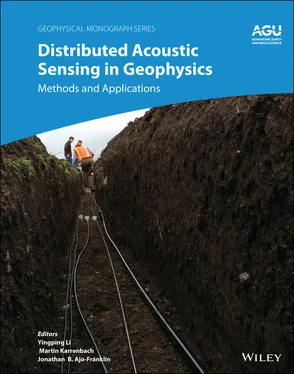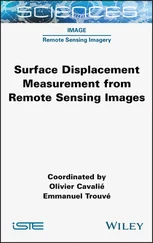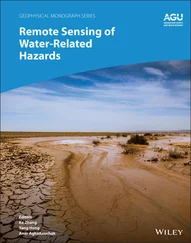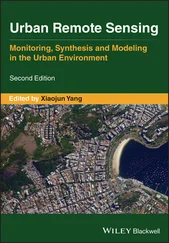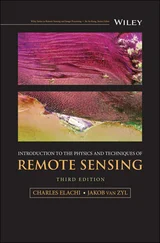Mark E. Willis1, Andreas Ellmauthaler1, Xiang Wu2, and Michel J. LeBlanc1
1Halliburton, Houston, Texas, USA
2Halliburton Far East Pte. Ltd., Singapore
Fiber‐optic distributed acoustic sensing (DAS) is a technology used for many strain measurement applications, including seismic monitoring. Because it is relatively new to the market, most geoscientists are unfamiliar with the details of the technology, but nevertheless are required to make important acquisition parameter decisions such as the type of fiber‐optic glass to use, the deployment method for the fiber‐optic cable, the gauge length, and how to diminish the effect of optical noise. This chapter provides a non‐theoretical, practical approach to making these decisions in order to obtain high‐quality DAS data sets.
The exciting and rapidly evolving technology of DAS, which uses optical fibers to sense local changes in strain, acquires seismic data for many applications, such as vertical seismic profiling (VSP) (Barfoot, 2013; Mestrayer et al., 2011; Mateeva et al., 2017), earthquake monitoring (Martin et al., 2017), hydraulic‐fracture geometry characterization (Jin & Roy, 2017), and microseismic monitoring (Hull et al., 2017). Improvements in the interrogator design (Hartog, 2017) and deployment methods (Ellmauthaler et al., 2020) have increased the signal‐to‐noise ratio (SNR) of the raw measurements, while processing improvements (Ellmauthaler et al., 2017; Chen et al., 2019; Willis et al., 2020) have allowed the removal of specific fiber‐optic noise patterns in the data.
Acquiring seismic data using accelerometers, geophones, and seismometers is a well‐developed and understood practice. Ironically, because it is so common, we rarely stop to question the actual field hardware used to acquire data or the software to process it; thus, it is frequently treated as a trusted commodity. In contrast, DAS technology is not as widely understood by the geophysics community, just as the requirements and applications of seismic data might not be generally grasped by fiber‐optic engineers and physicists who build and maintain DAS hardware and software. This situation creates the potential for degradations in the quality of seismic data acquired by DAS. This chapter describes the practical aspects for obtaining quality borehole seismic data using DAS to bridge the gap between fiber‐optic technologists and the geophysics community.
2.2. FIBER‐OPTIC SENSOR
2.2.1. Sensing from Backscattered Light
At the center of DAS technology is the fiber‐optic cable deployed in one of several ways as the seismic sensor. Unlike seismometers that are thought of as point sensors, a fiber‐optic cable senses strain along the entire fiber, which can be thousands of kilometers long. Because individual sensors do not make the measurement, it is referred to as a “distributed sensor measurement.” For ordinary telecommunication applications, a laser generates encoded light signals that pass information along the fiber to a distant receiver. Small defects or changes in the optical properties of the fiber along its length cause the light to be backscattered toward the laser source. The fiber is designed to minimize, by five to seven orders of magnitude as compared to the illuminating light, the amount of attenuation and backscattered light, so that data can be transmitted over large distances. However, this same unwanted backscattered light in telecommunications is used for DAS applications to detect and characterize local changes in the strain of the optical fiber from acoustic and seismic signals as well as from temperature changes.
When seismic waves or small temperature transients mechanically deform an optical fiber, the optical propagation properties of the fiber change, causing extremely small time delays during the travel path of the backscattered light. When a pulse of laser light is introduced into one end of the fiber, these small changes in the optical properties of the fiber create a continuous “shower” of scattered light emanating from virtually all points along the fiber as the pulse passes through. The timing change of the backscattered light forms the basis by which the strain, or deformation, of the fiber can be measured using an optical interrogation system.
2.2.2. Single vs. Multi‐mode Fiber
One of the first features to determine is the type of fiber to use as the seismic sensor. Practically all older fiber installations use multi‐mode fiber to enable the acquisition of temperature measurements using distributed temperature sensing (DTS). Most newer installations use a cable with two or more single‐mode and two or more multimode fibers inside. For DAS applications, single‐mode fiber currently provides the best SNR properties as compared to multi‐mode fiber. Single‐mode fiber has a small inner glass core diameter of 9 microns, which only allows a single, virtually direct path for the light to propagate; the light is totally internally reflected within the glass. On the contrary, multi‐mode fiber has a larger glass core diameter of 50 or more microns. While the light is still completely internally reflected, the wider glass core thickness allows for multiple paths, or modes, to be transmitted through the fiber. More light energy can be pumped into the multi‐mode fiber; however, the interference of the light pulse from the multiple paths can interfere with the quality of the DAS strain measurement. Thus, it is advisable to use single‐mode fiber for DAS measurements whenever possible. Multi‐mode fiber can be used for DAS measurements, but it usually requires additional optical hardware and does not normally provide an SNR as effective as single mode.
The next determination is how the fiber will be deployed as the seismic sensor. Figure 2.1shows three different deployment methods for DAS acquisition in a well. The retrievable fiber option uses an optical glass fiber installed inside either a wireline cable or coiled tubing. This option is by far the easiest to deploy, because it can be inserted into and removed from a well at any time. However, it is likely to have the lowest quality of strain measurement because the fiber is not directly coupled to the formation. A new method involves deploying a simple, disposable fiber‐optic glass line into the well (Higginson et al., 2017). In addition to the coupling issue, this method could encounter depthing problems, because there is no control of the tension (thus, placement) of the fiber in the well. Another option is to strap the fiber‐optic cable to production tubing; however, the highest quality comes from attaching the fiber‐optic cable to the outside of the casing, and cementing the casing. For this option, the fiber‐optic cable is directly coupled to the formation and has the best SNR of seismic signals propagating in the surrounding rock.
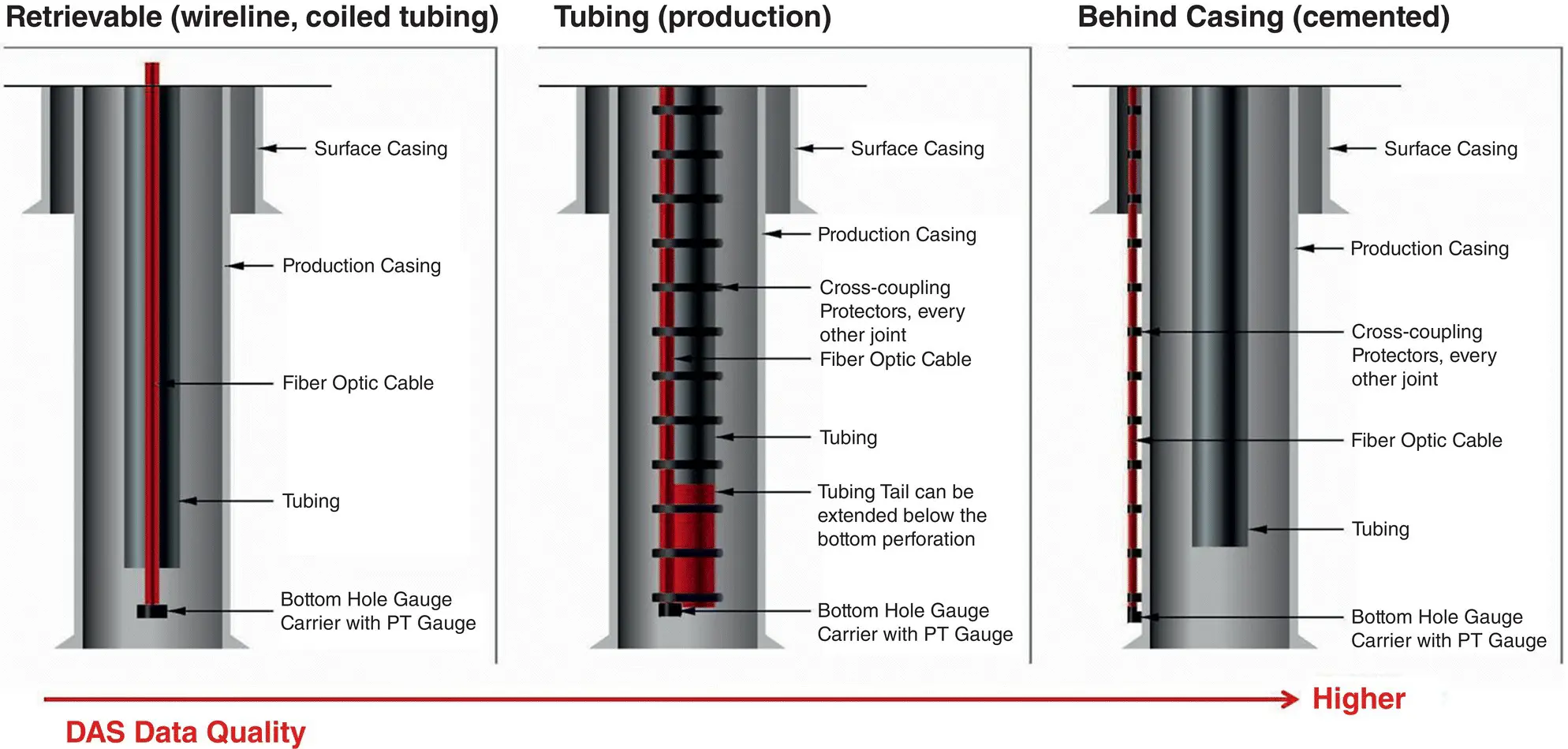
Figure 2.1 Options for acquiring DAS VSP data in a well.
To monitor teleseismic events, existing fiber‐optic telecommunication cables deployed in shallow‐buried conduits could be used (Martin et al., 2017). Described in the following section, the potential issue is that the broadside response of the fiber to strain is controlled by a cosine‐squared sensitivity to the angle of incidence for P waves, putting a null in the sensitivity for events arriving normal to the fiber. For yet another application, fiber‐optic cables buried in shallow trenches can be used to monitor surface waves, and then interferometric means can characterize the shallow earth properties (Martin et al., 2016).
Читать дальше
